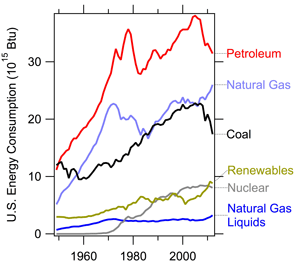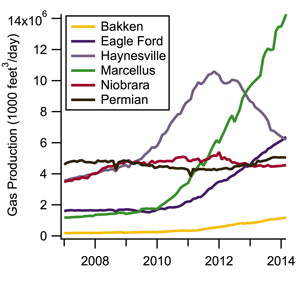A .gov website belongs to an official government organization in the United States.
A lock () or https:// means you've safely connected to the .gov website. Share sensitive information only on official, secure websites.
Energy production and use in the U.S. have seen rapid changes over the past decade. The domestic production of oil and natural gas has grown strongly, natural gas is increasingly replacing coal for the generation of electrical power, and the contribution from renewables has rapidly grown (Figure 1). Many of these shifts have caused significant changes in the atmospheric emissions of trace gases and fine particles that are at the root of the Nation’s air quality and climate change issues. However, since the changes in emissions are poorly known, the net effects for air quality and climate change are still very uncertain. Over the past decades, the U.S. has effectively addressed air quality issues and it is important to assure that the changes in our energy infrastructure do not negate some of these positive changes. Likewise, as the Nation is increasingly focused on mitigating the effects of climate change, it is important to know the net changes in emissions of greenhouse gases and other trace gases and fine particles that force the climate to change.


The domestic production of oil and natural gas from tight sand and shale formations is one change in our energy system that has received particular attention recently. Technological advances in directional drilling and hydraulic fracturing have made the production of oil and natural gas from tight sand and shale formations economically viable, and the production has increased strongly over the last decade (Figure 2). This increased production of oil and natural gas has been associated with emissions of methane, non-methane hydrocarbons and other trace gases to the atmosphere. The concerns about these emissions are three-fold:
In the SONGNEX mission, we will quantify the atmospheric emissions from various components of the U.S. energy infrastructure. We will also study how these emissions transform chemically in the atmosphere, and how these transformations contribute to ozone and fine particle formation. Specifically, we intend to focus on the emissions from a number of different tight oil and shale gas basins in the western U.S. The basins are chosen to represent a significant fraction of the production as well as different stages of the development of a basin. In addition, we will study several other components of the energy infrastructure, including surface coalmines in Wyoming, coal and natural gas power plants, a major intersection of crude oil pipelines in Oklahoma, and biofuel refineries where ethanol is made from corn.
The results of SONGNEX will give the information that is needed to (1) evaluate the effects of various energy sources and uses on climate, air quality and human health, and to (2) allow communities and society as a whole to make the best decisions to minimize these effects.



For further information, download the SONGNEX White Paper